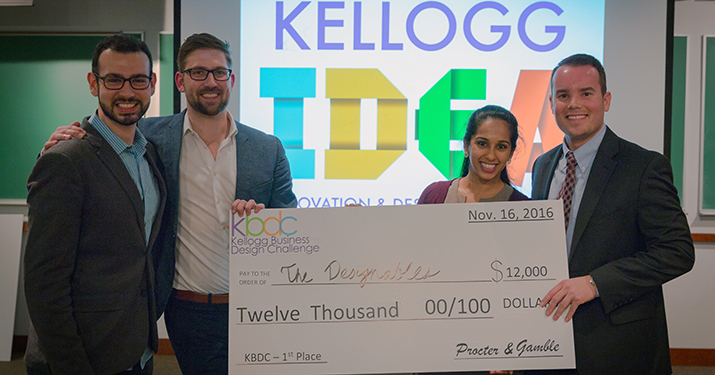MMM Students Win Kellogg Business Design Challenge

The Kellogg Innovation and Design Association (IDEA) Club sponsored its annual Kellogg Business Design Challenge (KBDC) on November 16.
During the KBDC, a corporate client presents student teams with a real-world challenge facing their industry. The competition culminates with five finalist teams presenting to representatives from the client as well as industry experts in front of a crowd of their Kellogg peers.
This year’s client, Proctor & Gamble, challenged the student teams to design a new foot care routine. The winning team, “The Designables,” consisted of Nick Anastasiades, Natasha Singh, Tom McIntyre, and Max Meyers. Three of them (Anastasiades, Singh, McIntyre) are enrolled in the MMM program. MMM students earn an MBA from the Kellogg School of Management and an MS in Design Innovation from Northwestern Engineering.
Their team interviewed users about their foot hygiene and proposed “Pedifresh,” a disposable daily freshening wipe for feet complete with anti-fungal and anti-bacterial agents to prevent foot odor.
Singh, a MMM Class of 2018 student, was surprised by how the design thinking process impacted her experience working with the rest of the team.
“It fueled an environment where we trusted each other and our research, a natural curiosity and willingness to be open to the unexpected, and, at the end of the day, a compelling story around a surprising yet relatable topic - dirty feet,” she said.
Nick Anastasiades, a MMM Class of 2018 student, explained how the MMM program prepared his team for this competition.
“The MMM program equipped us with the right mindset, research frameworks and creative confidence to go out and ask random strangers about what is usually a sensitive topic—their foot care routines,” said Anastasiades. “It seems so intuitive looking at the final result now, but behind these insights are dozens of interviews, prototypes and crumpled Post-it notes.”
One of the KBDC judges, Ajay Easo, Managing Director, Industry Strategy, at Fjord (part of Accenture Interactive) explained the importance of human-centered design.
“Putting people first is key to providing breakthrough solutions to sticky business problems,” he said. “It's great to see [Kellogg and the MMM program] immerse students with the tools and methods to be a champion for the user while tackling real world challenges.”
Another KBDC judge, Kathleen Brandenburg, founder and Chief Design Strategy Officer at IA Collaborative, agreed.
“A user-centered design approach is fundamental to innovation, because it uncovers insights not based on what people say they do, but what they actually do," she said. Being user-centered means getting as close to the user as possible to create something that the world never knew it needed, but now can’t live without.”
Even though "Pedifresh" is just an idea, the team feels it might have a real future as a product.
“Many of the people we talked to really would use them daily,” said McIntyre. “We proposed ‘before bed’ to penetrate peoples' routines, but we were also told by people they would use clean foot wipes after yoga practice, a long day of work, and a night out at the bar.”
While “The Designables” took home a check for $12,000 as a prize for their winning idea, the true value of the KBDC is in what they learned from participating.
“[KBDC is] a wonderful opportunity for potential partners, and obviously a great learning platform for students,” said Easo.
